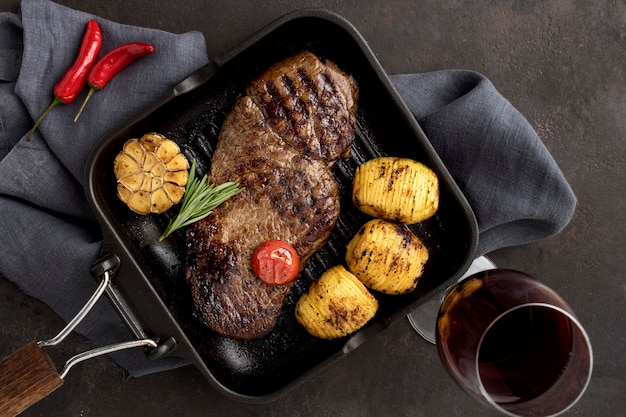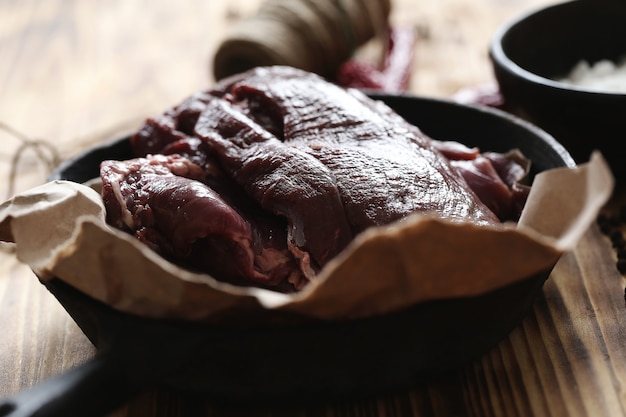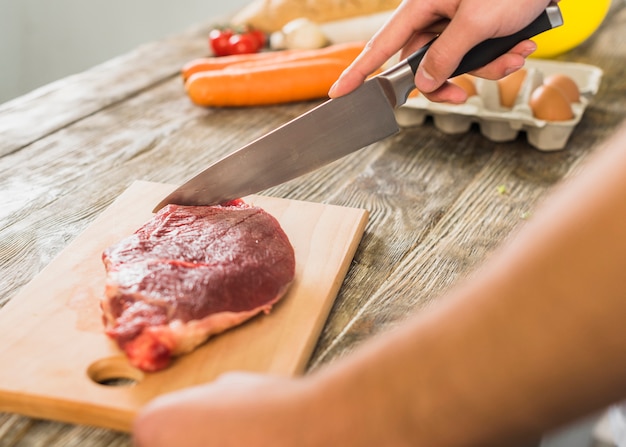Let’s be honest, the sight of a perfectly roasted prime rib, glistening with juices and boasting a gloriously crisp crust, is enough to make anyone’s mouth water. It’s a dish that screams celebration, a culinary masterpiece that brings people together. But, let’s face it, cooking prime rib can feel like a daunting task. It’s a cut that demands respect, a little know-how, and a bit of patience. But fear not, my culinary friend! I'm here to guide you through every step, from selecting the perfect roast to carving it like a seasoned pro, so you can achieve those perfect, juicy results every time. Trust me, once you've mastered this, you’ll be the king or queen of the kitchen!
Part 1: Choosing the perfect prime rib

The journey to a delicious prime rib starts with choosing the right cut. This is where a good butcher can be your best friend. They’ll have the knowledge to guide you based on your needs and preferences, whether it’s for a cozy dinner for two or a grand feast for a crowd.
Bone-In or Boneless: The Great Debate
First things first, bone-in or boneless? It's a question that divides even the most seasoned cooks. Bone-in ribs offer that classic, traditional flavour, with the bone acting as a natural moisture conductor. The downside? It can be a bit more challenging to carve, especially for newbies. On the other hand, boneless roasts cook more evenly and are a breeze to handle, but they might lack a touch of that traditional depth of flavour. Personally, I’m a sucker for that bone-in flavour, but it truly comes down to your personal preference.
The "Prime" Factor
Don’t settle for anything less than "Prime" when it comes to your prime rib. This grade ensures the highest quality beef, meaning a more tender and flavourful roast. You’ll also find a beautiful marbling throughout, which translates to a juicy and succulent end result. When choosing your roast, take a close look and make sure there’s a good amount of marbling running through the meat.
Sizing Up Your Roast
To avoid a scenario where you have too much or too little roast, it’s important to consider how many people you're feeding. A general rule of thumb is to allow 1 pound of prime rib per person. But, if you’re serving it with other dishes, you can go a bit lighter, allowing around 3/4 pound per person. And, if you're unsure, your butcher is always a great resource for advice on choosing the right size for your gathering.
Part 2: Preparing the Prime Rib for Cooking

You’ve got your prime rib, now it’s time to get it ready for its starring role in your culinary masterpiece. This involves a few simple yet crucial steps to ensure maximum flavour and tenderness.
Pat It Dry, My Friend
First things first, grab some kitchen paper and give your prime rib a good pat down. This step may seem insignificant, but it’s crucial. A dry surface helps create that beautiful, crispy crust we all crave, and prevents any excess moisture from steaming the roast, which can hinder browning.
Seasoning: A Symphony of Flavour
Now comes the fun part: seasoning. This is where you can really personalize your prime rib. My go-to approach is simple yet effective: generous amounts of coarse sea salt and freshly ground black pepper. It’s a classic combination that highlights the natural beef flavour. But, if you’re feeling adventurous, go for it! Herbs like rosemary, thyme, or garlic powder can add a beautiful depth of flavour. No matter what you choose, remember to rub the seasonings all over the roast to ensure even flavour penetration.
Resting is a Must
Once you’ve seasoned your prime rib, resist the urge to immediately toss it in the oven. The key to unlocking maximum flavour is to let it rest, uncovered, in the fridge for at least 2 hours, but ideally overnight. This gives the seasonings ample time to penetrate the meat, creating a symphony of flavour. Plus, resting makes carving a breeze, preventing those annoying, messy slips and slides.
Part 3: Cooking the Prime Rib to Perfection

The moment of truth has arrived – it's time to cook your prime rib! But before you crank up the heat, let’s talk about the different methods you can use to achieve that perfect roast.
Oven Cooking: A Classic Approach
oven roasting is the most common method, and it’s surprisingly simple. Preheat your oven to 450°F (232°C), ensuring the temperature is consistent for optimal browning. Place the roast in a roasting pan, and cook for 15 minutes per pound. Then, reduce the heat to 325°F (163°C), and continue cooking for another 15 minutes per pound. Keep a close eye on it, and use a meat thermometer to ensure it reaches your desired doneness. We’ll talk more about that later.
reverse sear: The Modern Masterpiece
Reverse searing is a modern technique that's gaining popularity for good reason. It produces a beautifully juicy and evenly cooked roast. The secret? Low and slow cooking followed by a high-heat sear. Start by preheating your oven to 250°F (121°C). Place the roast in the oven and cook for 2-3 hours, or until the internal temperature reaches about 120°F (49°C). Then, it’s time for the dramatic finale: remove the roast from the oven and crank up the heat to 500°F (260°C). Sear the roast for about 10 minutes, or until you achieve a glorious, crispy, golden-brown crust.
Roasting Pan vs. dutch oven: The Equipment Dilemma
When it comes to choosing your cooking vessel, a roasting pan is a reliable classic, but a Dutch oven offers a bit more magic. The lid traps moisture and creates steam, which results in a more tender and succulent roast. The added bonus? It also contributes to a beautiful, crispier crust.
Part 4: The Art of Checking Doneness
Doneness is paramount when it comes to prime rib. You want a roast that’s cooked through but still retains its juicy and tender texture. There are a few ways to check doneness, each with its own strengths and weaknesses.
Meat Thermometer: Your Culinary Compass
I can’t stress enough how essential a meat thermometer is. It’s the most accurate way to determine if your roast is cooked to your liking. Insert the thermometer into the thickest part of the roast, making sure it doesn't touch the bone. Here's a handy temperature guide for different doneness levels:
| Doneness | Internal Temperature (Fahrenheit) | Internal Temperature (Celsius) |
|---|---|---|
| Rare | 125-130°F | 52-54°C |
| Medium-Rare | 130-135°F | 54-57°C |
| Medium | 135-140°F | 57-60°C |
| Medium-Well | 140-145°F | 60-63°C |
| Well-Done | 145-150°F | 63-66°C |
The Touch Test: A Little More Hands-On
If you're feeling adventurous, you can try the touch test. It’s a bit trickier than using a thermometer, but it can give you a good estimate. Press your finger gently on the roast. If it feels soft and spongy, it's rare. If it's firm but gives slightly, it's medium-rare. If it feels firm, it's medium. And if it feels very firm, it's well-done.
The Bone Trick: A Classic Method
This method is a bit old-school, but it can be helpful if you're in a pinch. When the roast is almost done, stick a fork into the thickest part of the roast, near the bone. If the juices run clear, it's done. If the juices are pink, it needs a little more time.
Part 5: Resting is Crucial
Once your prime rib reaches your desired doneness, the cooking is technically done. But, hold your horses! The next step is absolutely crucial: resting. This is what separates the good prime ribs from the truly exceptional ones. Let your roast rest, covered with foil, for at least 15-20 minutes.
Why Resting is a Must
Think of it like this: when you cook a roast, the juices get pushed towards the centre of the meat. As it cools, those juices are drawn back out to the edges, creating a more evenly moist and flavorful roast. It’s like magic!
Don't Let It Cool Down Too Much
While resting is essential, you don't want your roast to become completely cold. Keeping it covered with foil helps trap heat, preventing it from becoming too chilly. Remember, you want to carve your prime rib while it’s still warm, ensuring juicy, tender slices.
Part 6: Carving the Prime Rib: A Masterclass
After all that effort, it’s time to carve your prime rib, unveiling that glorious masterpiece you’ve created. It might seem intimidating, but I promise, it’s easier than you think. Here's a simple guide to carving your bone-in prime rib:
Gather Your Tools
First, ensure you have the right tools for the job. You’ll need a sharp carving knife, a carving fork, and a cutting board. A good, sharp knife makes carving a breeze, so don't be afraid to ask your butcher to sharpen yours for you.
Step-by-Step Guide
- Place the roast on the cutting board, bone side down.
- Use the carving fork to hold the roast in place, keeping it secure as you slice.
- Starting at one end of the roast, slice against the grain, about ?? inch thick. You want to cut across the muscle fibers for the most tender slices.
- Continue slicing, working your way down the roast, removing the slices as you go.
- Once you reach the bone, carefully slice around it, removing the meat. You can use the tip of your knife to gently separate the meat from the bone.
- If you're serving the bone, you can use a cleaver to chop it into smaller pieces.
Don't Forget the Rib Bones
The bone is actually very flavorful, and many people enjoy gnawing on it. So, don't throw it away!
Part 7: Serving Up Your Prime Rib Feast
You’ve cooked a perfect prime rib. Congratulations! Now it's time to create the ultimate prime rib feast, a culinary experience that will leave your guests in awe.
A Feast Fit for a King
Prime rib is a dish that begs for classic sides that complement its richness and flavour. Here are a few of my favourite pairings:
- Roasted vegetables: Think roasted potatoes, carrots, Brussels sprouts, or asparagus. These vegetables add a touch of sweetness and earthiness to the dish.
- mashed potatoes: A creamy, comforting side dish that's perfect for mopping up the delicious juices from the roast.
- Yorkshire pudding: A fluffy, light, and airy pudding that adds a touch of elegance to the meal.
- Gravy: No prime rib is complete without a rich, flavorful gravy. You can make your own or use a store-bought version.
The Perfect Pairing: Wine
To elevate your prime rib feast, choose a wine that complements the rich flavour of the meat. A full-bodied red wine like Cabernet Sauvignon, Merlot, or Zinfandel will pair beautifully with the roast.
Part 8: Leftover Prime Rib: Don't Throw It Away!
You’ve probably cooked a generous amount of prime rib, but you might still have leftovers. Don't let them go to waste! There are tons of ways to use them, transforming them into tasty meals even days later.
Reheat and Reimagine
You can reheat your leftover prime rib in the oven, or even in the microwave. But, for the best results, slice it thin, and give it a quick sear in a pan. This will re-crisp the meat and make it even more delicious.
Prime Rib Sandwiches
Use the leftover prime rib to create mouthwatering sandwiches. Pile it high on toasted bread with your favourite toppings like cheese, caramelized onions, or horseradish sauce.
Prime Rib Hash
Dice the leftover prime rib and sauté it with onions and peppers, then serve it with a fried egg on top. This is a hearty and flavourful breakfast or brunch option.
Prime Rib Soup
You can even use the leftover prime rib to make a flavorful soup. Simmer it with broth, vegetables, and barley for a comforting and satisfying meal.
Part 9: FAQs
Q: How long does prime rib last in the fridge?
Prime rib will last in the fridge for 3-4 days. It's best to wrap it tightly in plastic wrap or aluminum foil to prevent it from drying out.
Q: Can I freeze prime rib?
Yes, you can freeze prime rib. Wrap it tightly in plastic wrap and then in aluminum foil, and freeze it for up to 3 months. To thaw, place it in the refrigerator for 1-2 days.
Q: Can I cook prime rib in a slow cooker?
While it's possible, it's not ideal. The slow cooker might not get hot enough to cook the prime rib properly. I recommend using a traditional oven or a Dutch oven.
Q: What’s the best way to carve prime rib?
Use a sharp carving knife and a carving fork. Slice against the grain of the meat, about ?? inch thick.
Q: What are the best sides to serve with prime rib?
Roasted vegetables, mashed potatoes, Yorkshire pudding, and gravy are all classic sides for prime rib.
Everyone is watching

Corn on the Cob: The Ultimate Guide to Perfectly Cooked Ears
Healthy MealsAh, corn on the cob. Just the name evokes images of sunny days, barbecues, and that sweet, juicy flavour that ...

Perfect Pork Roast Oven Cooking Time: A Guide to Delicious Results
Healthy MealsThere's something truly satisfying about a perfectly roasted pork. The aroma alone is enough to make your mout...

Ham Cooking Time: How Long to Bake, Smoke, or Boil a Delicious Ham
Healthy MealsAh, ham. It's a classic, isn't it? A real crowd-pleaser, especially around holidays. And when done right, it'...

Scallops: The Ultimate Guide to Perfect Cooking
Healthy MealsAh, scallops. Those delicate, sweet, and utterly delicious morsels of the sea. They hold a special place in my...

Spaghetti Squash: The Ultimate Guide to Cooking and Serving
Healthy MealsRemember that time you saw spaghetti squash at the supermarket, looking all bumpy and strange, and thought, "W...
